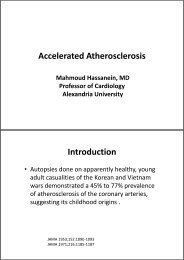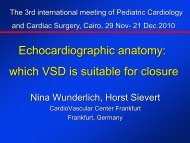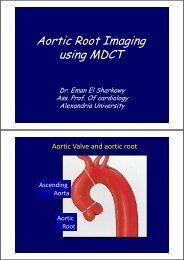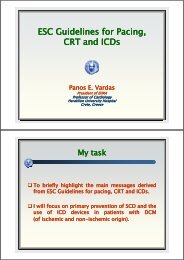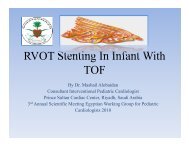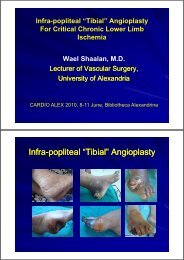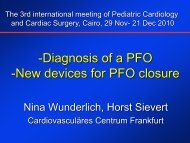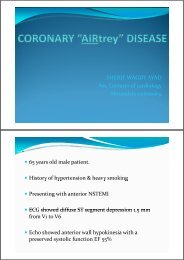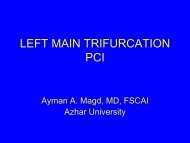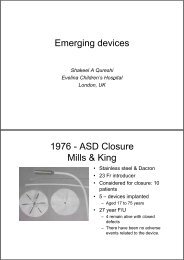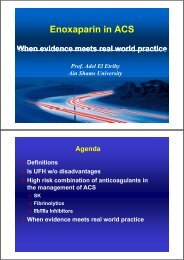Levosimendan therapy in CHF in Clinical Hospital Mostar
Levosimendan therapy in CHF in Clinical Hospital Mostar
Levosimendan therapy in CHF in Clinical Hospital Mostar
- No tags were found...
You also want an ePaper? Increase the reach of your titles
YUMPU automatically turns print PDFs into web optimized ePapers that Google loves.
<strong>Levosimendan</strong> <strong>therapy</strong> <strong>in</strong><strong>CHF</strong> <strong>in</strong> Cl<strong>in</strong>ical <strong>Hospital</strong> <strong>Mostar</strong>Emir Fazlibegović, ESC,FESCMustafa Hadžiomerović, ESC,FESCCl<strong>in</strong>ical <strong>Hospital</strong> <strong>Mostar</strong>, Bosnia and Hercegov<strong>in</strong>aCardio Alex PanArab 2010Alexandria-Egypt, 11 Jun 2010
WHAT IS HEART FAILURE?• “HF is a complex cl<strong>in</strong>ical syndrome that can result from any structuralor functional cardiac disorder that impairs the ability of the ventricle tofill with or eject blood. The card<strong>in</strong>al manifestations of HF are dyspneaand fatigue, which may limit exercise tolerance, and fluid retention,which may lead to pulmonary and peripheral edema.Both abnormalities can impair the functional capacity and quality of lifeof affected <strong>in</strong>dividuals, but they may not necessarily dom<strong>in</strong>ate thecl<strong>in</strong>ical picture at the same time.”Evaluation and Management of Chronic Heart Failure <strong>in</strong> the AdultA Report of the ACC/AHA Task Force on Practice Guidel<strong>in</strong>esFebruary 2002• Supply is less then demand• Failure of the heart as a pump
Systolic/Diastolic – does it matter?Systolic:• heart cannot contract normallyand cannot pump enough blood<strong>in</strong>to the arteries (EF40%)
Left, right, or both?Right Heart Failure• Results <strong>in</strong> <strong>in</strong>creased, systemic venouscongestion and peripheral edemaLeft Heart Failure• Results <strong>in</strong> pulmonary congestion
Different etiology – so what?• Many causes but cl<strong>in</strong>ical manifestationssimilar– Coronary artery disease is the underly<strong>in</strong>g cause of HF <strong>in</strong>approximately two thirds of patients with ischemic leftventricular systolic dysfunction.– The rema<strong>in</strong>der have no ischemic causes, e.g. hypertension,valvular disease, myocardial tox<strong>in</strong>s, or myocarditis– or may have no discernible cause (e.g., idiopathic dilatedcardiomyopathy).
Classification HFONSETETIOLOGYPATOPHYSIOLOGYLOCATION NYHA DIAGNOSISISCHEMICHEARTFAILUREACUTETOXICINFALMATORYSYSTOLICLEFTIIICardiac<strong>in</strong>sufficiencyCHRONICREUMATOIDDIASTOLICRIGHTIIICARDIOMIOPATHYIDIOPATICIVCardiacdysfunction
Congestive heart failure• The two primary goals of itsmanagement are prevent<strong>in</strong>g furtherdisease progression (mortality,hospitalizations and deterioration ofleft ventricular function) andalleviat<strong>in</strong>g patient suffer<strong>in</strong>g.
Treatment of Decompensated <strong>CHF</strong>67% 20% 8%5%DecompensatedHF PatientEdema (+)Warm ExtremitiesSBP > 90 mm HgHigh outputDecompensatedHF PatientEdema (+)Cold ExtremitiesSBP > 90 mm HgLow-output HFDecompensatedHF PatientEdema (-)Cold ExtremitiesSBP > 90 mm HgDecompensatedHF PatientEdema (+) or (-)Cold ExtremitiesSBP < 90 mm HgCardio shockOptimization of <strong>therapy</strong>:•Increase ACEI doses•IV diuretics•Other PO or IVvasodilators (nitroprusside)<strong>Levosimendan</strong>Dobutam<strong>in</strong>e/Dopam<strong>in</strong>e/Norep<strong>in</strong>ephr<strong>in</strong>eInadequate response:• Increas<strong>in</strong>g BUN• Persist<strong>in</strong>g edema• Persist<strong>in</strong>g dyspneaAdd Levo?
Contractile prote<strong>in</strong>s <strong>in</strong> cardiomyocytesAct<strong>in</strong>Ca 2+Tropomyos<strong>in</strong>cTnCTnIMyos<strong>in</strong> head (S1 fragment)ATP pocketRLCTnTELC
Calcium-Induced ConformationalChanges <strong>in</strong> Tropon<strong>in</strong> ComplexMyos<strong>in</strong> headTnIcTnCTnTCa 2+ Ca 2+ Ca 2+TnIAct<strong>in</strong>TmTnTTmTnIAct<strong>in</strong>TmMyos<strong>in</strong> headcTnCTmTnTTmAct<strong>in</strong>Myos<strong>in</strong> headCa 2+Myos<strong>in</strong> headTnIcTnCTmTnTAct<strong>in</strong>Myofilament lengthMyofilament length
Chemical DescriptionN<strong>Levosimendan</strong>NCCNHNNNHOH 3CHLipophilic pyridaz<strong>in</strong>one-d<strong>in</strong>itrile derivative
<strong>Levosimendan</strong>• Calcium sensitisation through b<strong>in</strong>d<strong>in</strong>gto tropon<strong>in</strong> C– <strong>in</strong>creases cardiac contractility and efficiency• Open<strong>in</strong>g of ATP-sensitive potassiumchannels <strong>in</strong> vascular smooth muscles– pulmonary, coronary, systemic vasodilation
Calcium Sensitization by<strong>Levosimendan</strong>No <strong>in</strong>crease <strong>in</strong> cAMPNo <strong>in</strong>crease <strong>in</strong> i/c calcium•No <strong>in</strong>crease <strong>in</strong> energy consumption•No arrhythmogenicity•No impairment <strong>in</strong> relaxation•Anti-stunn<strong>in</strong>g effect•No antagonism by -blockers
No Increase of EnergyConsumptionUkkonen et al. Abstract. Eur Heart J. 1998;(abstract suppl):547.
Myocardial Oxygen Consumption With PET(mean and SEM; N = 9)L/m<strong>in</strong>0.08p=0.15300.070.060.050.04levosimendan (18 µg/kg+ 0.3 µg/kg/m<strong>in</strong> for 5 h)placebo0.030.020.010Ukkonen et al, Cl<strong>in</strong> Pharmacol Ther 2000
Oxygen consumption - factors• All preserved myocardial cells contract• For each myofilament contraction there isan ATP split:ATP= ADP – Pi• Dur<strong>in</strong>g the relaxation phase, there is lowCa ++ concentration <strong>in</strong> the myocite and highconcentration <strong>in</strong> the sarcoplasmic reticulum• Ca-ATPase transports Ca ++ aga<strong>in</strong>st theosmolar grade[Note: Na + / Ca ++ exchange – no ATP is used, but rather theNa + transport (digitalis)]
Oxygen consumption - factors• Only about 25% of cross-bridges is used <strong>in</strong>the healthy heart (~6-7 out of 30)• The rest is the „Myocardial Reserve‟• MR is significantly depressed <strong>in</strong> HF• ATP-ase is down regulated <strong>in</strong> HT, which letsCa ++ to stay <strong>in</strong> the cell longer (elderly)<strong>Levosimendan</strong> the # of crossbridgeswithout of i/c Ca ++
Calcium Sensitization by <strong>Levosimendan</strong>characteristics• No excessive <strong>in</strong>crease <strong>in</strong> oxygen consumption– does not “waste” energy for <strong>in</strong>creased Ca 2+ cycl<strong>in</strong>g– does not change cross-bridge k<strong>in</strong>eticsuneconomically– stabilizes myofilament prote<strong>in</strong>s <strong>in</strong> the calcium<strong>in</strong>ducedorientation required for contraction– <strong>in</strong>crease the myocardial contractile force withoutimpair<strong>in</strong>g relaxationJanssen et al.,EJ Pharm, 2002,404;191-199
Does not Increase Risk ofArrhythmiasChanges <strong>in</strong> ambulatory ECG compared with basel<strong>in</strong>eS<strong>in</strong>gh et al. Am J Cardiol. 1999;83:16(I)-20(I).
Tim<strong>in</strong>g of <strong>in</strong>tracellular calcium transientrelative to contraction and relaxationIntracellular calcium transient and contraction–relaxation cycle<strong>Levosimendan</strong>ForcedevelopmentRelaxationOther Ca 2+ sensitisers:stronger non-specificb<strong>in</strong>d<strong>in</strong>g of calciumto tropon<strong>in</strong>-CTime
Coronary blood flowLilleberg et al. Eur Heart J. 1998;19:660-668.
Pharmacok<strong>in</strong>etics• Load<strong>in</strong>g dose:– time to steady state -4 hours– peak effect - 0.2-0.5 hours• Ma<strong>in</strong>tenance <strong>in</strong>fusion:– time to steady state -2 hours– peak effect - 4 hours– duration of effect - 2hours•Volume of distribution at steady state 0.19L/kg• Prote<strong>in</strong> b<strong>in</strong>d<strong>in</strong>g 98%• Half-life 1 hour
<strong>Levosimendan</strong>-Metabolites• Ma<strong>in</strong> metabolic route = conjugation withglutation.• After 24 h <strong>in</strong>fusion about 5 % of the doseis metabolized to OR-1855 and OR-1896.• <strong>Levosimendan</strong> is reduced by <strong>in</strong>test<strong>in</strong>albacteria to an am<strong>in</strong>e metabolite (OR-1855)which is further acetylated (OR-1896)• Accumulation of OR-1896 occurs afterlonger <strong>in</strong>fusions of levosimendan.• OR-1855 and OR-1896 <strong>in</strong> vivo are atequilibrium.
Active Metabolites of<strong>Levosimendan</strong>• Correspond to 5% of total metabolism oflevosimendan• Elim<strong>in</strong>ation half-life about 80 h <strong>in</strong> patients• About 40% bound to plasma prote<strong>in</strong>s• Haemodynamic profile similar to levosimendan• As potent a calcium sensitizer as levosimendan
Active Metabolite-PK parameters• OR-1896– half-life 80 hours– prote<strong>in</strong> b<strong>in</strong>d<strong>in</strong>g 61%– peak effect 48-72 hours afterlevosimendan <strong>in</strong>fusion– duration of effect ~7 days (HR & BP)
Concentration (ng/ml)Pharmacok<strong>in</strong>etics of levosimendan <strong>in</strong> patientswith heart failure (Study 3001058, iv)807060Dose: 0.2 µg/kg/m<strong>in</strong> for 24 h<strong>Levosimendan</strong>OR-189650403020t ½ (h)C max (ng/ml)T max (h)<strong>Levosimendan</strong>OR-189677 ± 91.3 ± 0.124 a 72 (48-120) b62.6 ± 8.4 5.5 ± 0.61024 h <strong>in</strong>fusion00 1 2 3 4 5 6 7 8 9 10 11 12 13 Time (days)(mean ±SEM), n=12 a end of <strong>in</strong>fusion, b median (range)(mean ±SEM), N=12 a end of <strong>in</strong>fusion, b median (range)3001058, group 4
Mean plasma concentrations (ng/mL) of levosimendandur<strong>in</strong>g and after one week cont<strong>in</strong>uous <strong>in</strong>fusion (0.1 and0.05 µg/kg/m<strong>in</strong>) (N = 12)Concentration (ng/mL)4440levosimendan 0.1 µg/kg/m<strong>in</strong>levosimendan 0.05 µg/kg/m<strong>in</strong>36322824201612840Study 3001058Infusion time1 2 3 4 5 6 7 8Time (days)
Mean (±SEM) plasma concentrations of levosimendanand its metabolites dur<strong>in</strong>g and after one week cont<strong>in</strong>uous<strong>in</strong>fusion (0.1 µg/kg/m<strong>in</strong>) (N=12)Concentration (ng/mL)4540<strong>Levosimendan</strong>OR-1855OR-18963530252015105Infusion time01 2 3 4 5 6 7 8 9 10 11 12 13 14 15 16 17 18Study 3001058Time (days)
<strong>Levosimendan</strong> <strong>in</strong> SpecialPopulations• Age- no differences• Sex- no difference when adjusted forweight• Liver dysfunction- reduced elim<strong>in</strong>ationof metabolites• Renal dysfunction- decreased prote<strong>in</strong>b<strong>in</strong>d<strong>in</strong>g and slower elim<strong>in</strong>ation
Dose-escalation Study:Symptomatic Improvements at 6 HoursSlawsky et al. Circulation. 2000;102:2222-2227.Kivikko et all, Circulation, 2003
Dose-escalation Study:Haemodynamic Improvements at 6 HoursSlawsky et al. Circulation. 2000;102:2222-2227.Kivikko et all, Circulation, 2003
Dose-escalation StudyComb<strong>in</strong>ed Significant Haemodynamic Improvements at 6 HoursSlawsky et al. Circulation. 2000;102:2222-2227.Kivikko et all, Circulation, 2003
Dose-escalation Study:Change <strong>in</strong> Stroke Volume OverTimeSlawsky et al. Circulation. 2000;102:2222-2227.Kivikko et all, Circulation, 2003
Dose-escalation Study:Change <strong>in</strong> PCWP Over TimeSlawsky et al. Circulation. 2000;102:2222-2227.Kivikko et all, Circulation, 2003
IHD and Cardiac surgery• RUSSLAN study– 504 patients with recent MI, levo vs.placebo. Trend to lower mortality at 180days.• Small studies <strong>in</strong> cardiac surgery showlevosimendan <strong>in</strong>creases cardiac outputand lowers SVR
Kaplan-Meier curve
<strong>Mostar</strong> study <strong>in</strong> 20 patientsNYHA III-IV• Aged 43-84, average 69• All patients treated with ACE <strong>in</strong>hibitors,diuretic, beta blockers, aldosteroneblockers, stat<strong>in</strong>s, and cardiotonics (digox<strong>in</strong>chronically and dobutam<strong>in</strong>, dopam<strong>in</strong>e <strong>in</strong> theshortly crisis period).• On follow-up 1-3 day after <strong>in</strong>fusion and 3and 6 month, and 1-2-3 year after.
Dos<strong>in</strong>g and Adm<strong>in</strong>istration• Give a load<strong>in</strong>g dose of 12-24 mcg/kg <strong>in</strong>fused over 10 m<strong>in</strong>• Follow with a ma<strong>in</strong>tenance <strong>in</strong>fusion of 0.1 mcg/kg/m<strong>in</strong>over 24h• Assess patient response after 30 to 60 m<strong>in</strong>– If the response is deemed excessive, decrease<strong>in</strong>fusion rate to 0.05 mcg/kg/m<strong>in</strong> or discont<strong>in</strong>ue– If the <strong>in</strong>itial dose is tolerated and an <strong>in</strong>creasedhemodynamic effect is required, <strong>in</strong>crease <strong>in</strong>fusion rateto 0.2 mcg/kg/m<strong>in</strong>• Individualize dose and duration of treatmentaccord<strong>in</strong>g to the patient‟s cl<strong>in</strong>ical condition andresponse.
<strong>Levosimendan</strong> and NYHANYHA kl.4444 4 444444444 4 43,5333 3 3 3 3 3333 33 3333 3 32,522 222222221,510,501 2 3 4 1 2 3 1 2 3 1 2 1 2 1 2 1 2 3 1 2 1 2 1 2 1 2 1 2 1 2 1 1 1 2 1 2 1 2 1 2 1 2
<strong>Levosimendan</strong> and NYHAMean=-1.0000 Std Dev=0.6124 P< 0.0001
EFLV <strong>in</strong> patients withlevosimendanEF90%80%82%70%72%69%71%64%60%50%40%30%48%27%58%55%53%35%33%38%45%37%57%32%45%41%43%27%57%26%45%37%27%35%32%59%36%44%36%26%32%39%37%52%20%17%20%20%17%21%10%0%1 1 1 1 2 2 2 3 3 3 4 4 5 5 6 6 7 7 7 8 8 9 9 10 10 11 11 12 12 13 13 14 15 16 16 17 17 18 18 19 19 20 20
<strong>Levosimendan</strong> and EFLVMean=15.7059 Std Dev=14.3952 P= 0.0004
<strong>Levosimendan</strong> and ENDLVEndLV109876543217,3 7,7 6,15,66,8 6,9 6,95,95,4 5,655,69,27,95,5 5,25,9 5,7 5,8 5,99,89,27,976,67,36,6 6,4 6,3 6,55,7 5,9 5,96,15,44,88,7 8,8 9 8,7 8,88,101 1 1 1 2 2 2 3 3 3 4 4 5 5 6 6 7 7 7 8 8 9 9 10 10 11 11 12 12 13 13 14 15 16 16 17 17 18 18 19 19 20 20
<strong>Levosimendan</strong> and FSFS60%50%51%20%10%7%25%23%20%21%11%22%13%13%12%23%18%15%24%17%17%22%20%17% 18% 19%20%16%12%40%42%40%29% 31%17%28%18%16%13%39%41%30%30% 32% 35%31%32%0%01 1 1 1 2 2 2 3 3 3 4 4 5 5 6 6 7 7 7 8 8 9 9 10 10 11 11 12 12 13 13 14 15 16 16 17 17 18 18 19 19 20 20
Distrubtion of FS withlevosimendanMed=0.0818 SD=0.0915 P= 0.002
Conclusion 1• Experience from our practice showsthat s<strong>in</strong>gle dose of <strong>Levosimendan</strong> <strong>in</strong>patients with decompensatedadvanced heart failure producessignificant improvement, which reflects<strong>in</strong> extension of life.
Conclusion 2• Use of <strong>Levosimendan</strong> seams to bebeneficial demonstrated by greatbenefit <strong>in</strong> the quality of life with bettersystolic function without anyarrythmogenic effect.
Conclusion 3• There are probably other benefitsmasked by uknown lusitropic andpleotropic <strong>in</strong>fluences of <strong>Levosimendan</strong><strong>in</strong> the physiology and pathophysiologyof heart and others systems of body.
Conclusion 4• Almost all cases of death are results ofco-morbidity disease, and are notrelated to levosimendan effect• ICD device• Cardiac surgery• TransplantationIn the future



